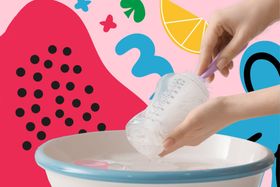How to Supplement with Formula While Breastfeeding
Learn how to safely and effectively supplement your baby's breastfeeding journey with formula, ensuring their optimal nutrition
Updated September 23, 2024

As a new parent, all you want is to give your child the best start—including their nutrition. Breastfeeding often feels like the natural choice, but life can throw unexpected curveballs. Sometimes, exclusive breastfeeding can become difficult or impossible. [1]
Whether you're seeking flexibility or facing challenges, let's explore the options available and find the best approach for your family.
» Supplement your baby's breastfeeding journey with a nutrient-rich formula
Is It Okay to Supplement with Formula?
The short answer is yes, it's absolutely okay to supplement with formula! Every family's situation is unique; what works best for one may not work for another. The decision to supplement should be based on your circumstances, your baby's needs, and your preferences.
Supplementary formula, also known as "top-up feeds," "mixed feeding," or "combination feeding," refers to the practice of giving formula in addition to breastfeeding. This can range from occasional supplementation to regular mixed feeding.
Supplementing with formula has many benefits:
- It can reduce stress and anxiety related to milk supply issues and relieve pressure on the breastfeeding parent.
- Partners or other caregivers can participate in feeding, promoting bonding, and giving the breastfeeding parent breaks.
- It provides flexibility, making managing work schedules or other commitments easier.
- Formula may keep babies full for longer, leading to longer sleep stretches and improved sleep patterns.
- Introducing formula can make the eventual transition to solid foods smoother.
» Learn why choosing organic is the healthy option for your baby
Reasons for Supplementing with Formula
Though many parents plan to breastfeed exclusively, the reality is that only about 40% of babies globally are fed this way in their first six months. [2] This statistic highlights that combining breast milk and formula is a common and perfectly valid choice.
There are several reasons parents might choose to supplement:
- Delayed Milk Supply: Some women experience a delay in their milk coming in, leading to concerns about the baby's nutrition in the first few days.
- Inadequate Infant Growth: If your baby isn't gaining weight as quickly as they should, your doctor might suggest adding some formula.
- Medical Reasons: Certain health conditions can make breastfeeding difficult, such as if you're taking specific medications or your baby has a condition like galactosemia.
- Low Milk Supply: Even if you're doing everything right, you might not produce enough milk to keep your baby satisfied.
- Returning to Work: Maintaining exclusive breastfeeding can be challenging when returning to work, especially if there aren't suitable places to pump.
- Maternal Mental Health: Sometimes, the pressure of exclusive breastfeeding can affect a mother's mental health, and supplementing can provide needed relief.
- Multiple Births: If you have more than one baby, it can be challenging to produce enough milk for all of them.
» Explore these tips for transitioning from breastfeeding
Signs Your Baby Might Need Formula
While every baby is different, here are some indications that your baby might benefit from supplemental formula:
- Weight Issues: If your baby isn't regaining birth weight by two weeks old or is gaining weight slowly, they might need the extra nutrition from formula.
- Insufficient Dirty Diapers: For babies over a week old, less than 6–8 wet diapers in 24 hours could indicate that your baby isn't eating enough.
- Signs of Dehydration: These include dry mouth, lack of tears when crying, sunken fontanelle (soft spot), and decreased urine output.
- Extreme Fussiness: All babies have fussy periods, but lasting unhappiness or unusual sleepiness could be due to hunger.
- Prolonged Feeding: If your baby is constantly nursing but still seems unsatisfied, it might be a sign that they need more milk
- Missing Milestones: While all babies develop at their own pace, consistent failure to meet developmental milestones could indicate nutritional deficiencies.
If you notice any of these signs, consult your pediatrician. They can assess your baby's growth and help determine if supplementation is necessary.
» Tired of commercial formulas? Check out these alternatives
When and How to Start Introducing Formula
Timing when to start can vary based on individual circumstances. Here's a guide for different stages:
From Birth
Some parents begin supplementing with formula immediately after birth due to medical necessities such as low birth weight, jaundice, or maternal health issues affecting milk production. In these cases, hospital staff will guide you on supplementing, often using small syringes or specialty bottles designed for newborns.
» Discover the importance of nutrition in the first 1000 days
During the First Few Weeks
If your baby isn't regaining birth weight quickly enough or the you're experiencing challenges with milk supply, your doctor might suggest using combination feeding in the first few weeks.
Start by offering small amounts of formula (1–2 ounces) after breastfeeding sessions. Use slow-flow nipples to mimic the pace of breastfeeding.
» Don't let your baby's weight gain be a concern
Around 4–6 Weeks
This is a popular time to introduce formula for mothers planning to return to work. It provides enough time to establish a milk supply while letting the baby adjust to bottle feeding. Begin by replacing one breastfeeding session with a bottle of formula, gradually increasing as needed.
2–4 Months
As babies grow, their nutritional demands increase. Some mothers find their milk supply can't keep up. Start by offering a bottle for one feeding a day. Use paced bottle feeding techniques to avoid overfeeding, and consider trying middle-of-the-night feeding to encourage longer sleep stretches.
» Learn about night-time feeding with formula
4–6 Months
Some parents also introduce combo feeding when babies start their journey with solid foods. This can help ease the transition to a more varied diet. Try replacing one or two breastfeeding sessions daily with formula feeds, often those that align with family mealtimes.
6+ Months
If you plan to stop breastfeeding before a year, starting formula now can be part of the gradual weaning process. Begin replacing breastfeeding sessions with formula feeds one at a time, usually starting with the midday feeds and gradually moving to morning and evening feeds.
Regardless of when you start, introduce formula gradually. Begin by replacing one feeding at a time, allowing several days between introducing new formula feeds. This gradual approach helps you and your baby adjust to the new feeding routine and reduces the risk of engorgement for the mother.
» Start your baby's journey to solids with wholesome baby cereal
Choosing the Right Formula
This decision is crucial, directly impacting an infant's growth and development. Several factors should be considered when making this choice:
- Age: Formulas are specifically designed for different stages of a baby's development. Newborn formulas have a nutrient profile that mimics early breast milk, while options for older infants have added ingredients to support their growing nutritional needs.
- Nutritional Content: Look for options fortified with iron, which is essential for cognitive development and preventing anemia. Prebiotics and probiotics are often used to support digestive health, and DHA and ARA are necessary for brain and eye development.
- Digestibility: If your baby seems uncomfortable after feeding, or has excessive gas or changes in stool consistency, you might need something designed for sensitive tummies.
- Allergies: Consider family history, as your baby may be at higher risk of developing allergies. Dairy-free, gluten-free, and soy-free options reduce allergen risk while maintaining nutritional value.
» Discover our expert tips for finding the right formula for your baby
Best Way to Introduce a Bottle
If you've been exclusively breastfeeding, here are some tips to make the transition to a bottle smoother:.
- Choose the Right Bottle: Choose a bottle with a wide, breast-shaped nipple with a slow flow to create a more familiar feeding experience for your baby and avoid overfeeding.
- Have Someone Else Offer the First Bottle: Babies can smell their mothers' milk, which might make them refuse a bottle if their mothers are nearby.
- Experiment with Temperature: Some babies like milk at body temperature, while others prefer it cooler.
- Try Different Positions: Hold your baby differently from your usual breastfeeding position.
- Be Patient: It may take several attempts before your baby accepts the bottle. Don't force it if your baby is resistant; try again later.
- Practice Paced Bottle Feeding: This involves holding the bottle horizontally and letting the baby draw formula in and out, similar to breastfeeding.
- Start Small: To help your baby adjust, start with just 1–2 ounces in the bottle.
- Maintain Skin-To-Skin Contact: Keep your little one close even when bottle feeding to maintain that bonding experience.
» Find out how to switch from ready-made to powder formula
How to Prepare Baby Formula
Always follow the instructions on the formula label. Here's a detailed guide:
- Wash your hands thoroughly with soap and water.
- Sterilize bottles and nipples for newborns. For older infants, a good washing is usually sufficient.
- Use safe water. If you're unsure about your water quality, boil it for 1 minute and let it cool before use.
- Add the right amount of water to the bottle first.
- Add the recommended amount of formula powder using the scoop provided.
- Mix thoroughly by gently shaking or swirling the bottle.
- Warm the bottle if desired by placing it in a bowl of warm water. Never use a microwave, as it can cause hot spots.
- Test the temperature by putting a few drops on your inner wrist. It should feel lukewarm, not hot.
» Support your baby's development with formula designed for combination feeding
Effects on Milk Supply
Milk production works on a supply-and-demand basis, so reducing nursing or pumping sessions can decrease milk supply. But, with proper management, it's often possible to maintain your desired level of milk production while combo feeding. Here are some strategies:
- Continue Regular Breastfeeding: Offer the breast first at feeding times when you're available.
- Pump After Formula Feedings: This signals your body to produce more milk and can help maintain supply.
- Use Paced Bottle Feeding: This technique mimics breastfeeding and prevents overfeeding, which could lead to less interest in nursing.
- Try Power Pumping: This involves short, frequent sessions to mimic cluster feeding and boost supply.
- Stay Healthy: Maintain proper nutrition and hydration, crucial for milk production.
Even if your milk supply decreases, partial breastfeeding still has many benefits for your baby.
» Check out the signs that indicate feeding issues in your baby
Will Using Formula Affect My Baby?
Introducing formula can affect your baby in several ways:
- Digestion: Formula can take longer to digest than breast milk, potentially leading to changes in stool, increased spit-up, and gas initially. Smaller feedings and burping often can help with digestion and reduce discomfort.
- Feeding Patterns: Formula-fed babies often go longer between feedings as formula keeps them fuller for longer.
- Immune System: While formula doesn't provide the same immune-boosting properties as breast milk, many modern formulas are fortified with prebiotics and probiotics to support immune function.
- Allergies: Some babies may be sensitive to specific formulas. Watch for signs of allergies or intolerance, such as excessive fussiness, rash, or changes in stool.
- Nipple Confusion: While this can happen, many babies switch between breast and bottle without issues. Using paced bottle feeding and breast-shaped nipples can help. [3]
- Growth Patterns: Formula-fed babies may have slightly different growth patterns than exclusively breastfed babies. Your doctor will check their growth regularly to make sure they're on track.
- Bonding: While breastfeeding provides skin-to-skin contact, bottle feeding can also be a bonding experience, especially when done with eye contact and closeness.
» Learn more about food allergies in babies
Feeding Your Baby the Best
Whether you choose exclusive breastfeeding, formula feeding, or a combination, the goal remains the same—a thriving infant and a mother in good health, physically and emotionally.
Whatever your reasons, there are options tailored to meet your baby's specific nutritional needs and your peace of mind. From organic and hypoallergenic formulas to Clean Label certified and sugar-free options, you can find a choice that aligns with your highest standards.
» Combine the natural benefits of breastfeeding with the nutritional support of formula
The content and advice provided in this article are for informational purposes only and are not a substitute for medical diagnosis, treatment, or advice for specific medical conditions. Always consult a pediatrician to understand the individual needs of your child.









